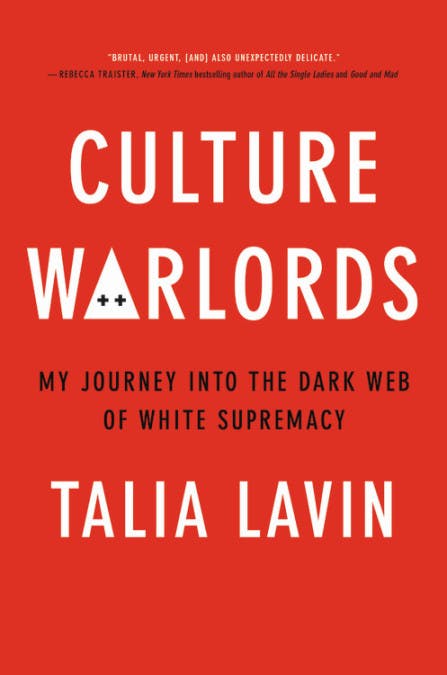There is a long and noble tradition in this country of journalists going undercover to expose the far right. More than a century ago, Walter White—a Black man so light-skinned he could easily pass for white—made a name for himself by infiltrating Southern lynch mobs, gathering evidence against them, and then broadcasting their evil deeds to a broad reading public. In the 1940s, Stetson Kennedy impersonated a racist encyclopedia salesman to penetrate the ranks of the Ku Klux Klan and then humiliated them by divulging their closely guarded secrets on a children’s radio show. In the late 1970s, Dick Lehr paid $28 for robes and joined the Connecticut chapter of David Duke’s Knights of the Ku Klux Klan, in an effort to “get inside Duke’s local outfit, identify his local leader and either verify or debunk his headcount of followers.”

Into this remarkable pantheon of investigators enters Talia Lavin, a journalist and self-described “schlubby, bisexual Jew, living in Brooklyn, with long brown ratty curls, the matronly figure of a mother in a Philip Roth novel, and a brassy personal politic that’s not particularly sectarian but falls considerably to the left of Medicare for All.” As she describes in her impassioned new book, Culture Warlords: My Journey Into the Dark Web of White Supremacy, Lavin spent a full year infiltrating the online safe spaces of a panoply of modern white supremacists, from incel message boards to a European neo-Nazi terror propaganda cell. For these efforts, as well as her earlier journalism and activism, Lavin has become a regular target and particularly loathed figure among the far right; they have published her relatives’ names on white supremacist social media sites, sent her parents a postcard bearing a Nazi slogan, and discussed in chat rooms “whether I was too ugly to rape.”
These days, there is, to be sure, no shortage of studies of white supremacy, from the trenchant scholarship of Alexandra Minna Stern and Kathleen Belew to the powerful reporting of Vegas Tenold and David Neiwert. Where precisely Lavin’s book fits in this firmament may, at first, seem a bit unclear. Culture Warlords is not truly a history or an ethnography or a memoir or even really a travelogue from racist site to racist site. It belongs, rather, to an older model of writing. It is a jeremiad, in the very best sense. There may be deeper, more comprehensive studies of the far right, but the value of Culture Warlords is its anger. It is appropriate that the current profile picture on Lavin’s prolific Twitter account shows her wielding a massive sword. With her frankness and unapologetic partisanship, Lavin models an activist-journalist-scholar approach, the writer as warrior.
As she mentions early in Culture Warlords, Lavin’s first experience with antisemitism came online. She grew up attending Orthodox Jewish schools in a neighborhood of Teaneck, New Jersey, known colloquially as the “Hebrew Hills.” The granddaughter of Holocaust survivors, hers was a childhood “in which every meaningful personal relationship I had was with a Jew.” As a result, antisemitism was largely abstract to Lavin until adulthood, when she took a job as an editorial intern with the tiny, venerable Jewish Telegraphic Agency. At this time, she felt secure in her “secular, cultural Judaism,” but she quickly learned that one of the main traffic drivers to JTA was the white supremacist website Stormfront.org. It turned out the neo-Nazis reveled in stories about Jews—Jews behaving badly, Jews exercising power, Jews identified publicly as Jews. Reading the graphic, anonymous threats they sent made her “bones ache,” Lavin writes, but from that moment, she knew she was “going to fight.”
Culture Warlords is an account of a year in that battle. On June 1, 2019, Lavin joined more than 90 far-right and white supremacist groups on the encrypted messaging app Telegram. There, she went by “Tommy” and just lurked and observed. Soon, though, she became more active. Lavin decided to endow Tommy with an anime porn addiction and have him join an online incel forum. Though one survey suggested that 40 percent of incels—short for “involuntary celibate”—are people of color, Lavin found that racism was rife in their online spaces, with “radicalized misogyny” leading users “straight into the arms of white supremacy.” Soon Tommy transformed into a pickup-driving West Virginian “holy warrior for Christ” and joined several white nationalist online religious groups. There, Lavin studied the bizarre and vitriolic conflict between white supremacist Christians (who celebrate mass murders of Jews and Muslims and view the Crusades as something of a Lost Cause) and white supremacist pagans (who loathe Jesus as a Jew and are drawn instead to the Norse gods by the lure of “what they see as an all-white religion, freed from the taint of Jewish perfidy”).
Lavin also experimented with female white supremacist personas. She joined a website called WhiteDate.net as “Ashlynn,” a blonde, gun-toting Aryan from a “farm-slash-compound” in Iowa. Her goal was “to nudge as many men on WhiteDate as possible to reveal as many personal details as possible, so that I could, ultimately, out them as white supremacists.” Ashlynn was briefly overwhelmed by messages and even love letters from lonely, horny Nazis, but most were too cagey to divulge much personal information, so Lavin transformed the experiment into what she began thinking of as an anthropological study of the “rank and file.” Ashlynn also joined the Vorherrschaft Division, a Nazi-inspired chat group for Americans and Europeans to fantasize about gun violence and the need for an imminent race war. Armed with the screen name AryanQueen, Ashlynn flirted extensively with a high-ranking Ukrainian neo-Nazi, eventually obtaining enough identifying information for Lavin to leak his true identity to journalists.
Much of the anthropological information Lavin conveys about these white supremacist online communities is, sadly, no longer surprising. Users of white supremacist online dating sites sweet-talk each other with visions of perpetuating the pure white race. The incel chat rooms featured a misogyny “so vitriolic it seemed to burn my eyes through the screen.” Some white supremacist online spaces were mere repositories for bigoted memes; others featured how-to guides for committing a mass shooting. YouTube is a vital factor in radicalizing many angry, young men, the site’s algorithm gradually exposing them to more and more venomous content. There is a vicious feedback loop between the online far right and “the mainstream Republican Party”—even if white supremacists are more likely to dislike corporations, Israel, and foreign wars, or grow frustrated with Trump for not being racist enough.
But Lavin also reveals less well-known information, which shines a light on the profound unreality of modern racist communities. She notes that online white supremacists frequently use Yiddish terms (including goyim, yenta, oy vey, and Shoah) to “display supposedly insider knowledge of Jewish culture.” The nearly all-male members of these communities also “revel” in “homoerotic humor,” in spite of their professed homophobia. There is a disturbingly sizable contingent of military members on WhiteDate.net.
Some journalists might hesitate to give these groups the detailed coverage that Lavin does here. When these groups gain so much attention, they might argue, it creates the impression that they occupy a more central position in the culture than they really do. Lavin, for one, does not believe that media outlets should give neo-Nazis a platform in public debate (“The effect of these ideas when they are aired out is much like Zyklon B,” she writes), but she argues that reporting on and exposing them is different. “Being able to trace, isolate, and identify these ideologies,” she writes, “means that racists can’t hide behind slippery code words or private vocabularies.” To expose their identities and hound them from public life is not the same as giving them a pulpit. The former is a vital tool in the fight against fascism; the latter is essentially what gave us Trump.
If the way to defeat Nazis is not to debate them, what precisely does Lavin propose? The answer to that question can be found in her final two chapters, as well as the book’s epigraph: “No pasarán!”—they shall not pass—a quotation made famous by the Communist leader Dolores Ibárruri speaking to the besieged city of Madrid in 1936, desperate to repulse the Fascist onslaught. The idea behind “no pasarán” is simple—that the legions of evil shall not be permitted to advance—and ancient, bringing to mind Job 38:11, rendered in the King James translation as, “Hitherto shalt thou come, but no further.”
For the better part of a century, Lavin writes, the forces of anti-fascism have relentlessly opposed the forces of fascism. Emerging out of the guerilla opposition to Mussolini and Hitler in the 1920s and 1930s, antifa activism can be traced directly through the celebrated underground resistance movements of World War II to British anti-fascists who, in the 1950s and 1960s, harried a fascist resurgence out of existence, to the “black bloc” protesters of today. (For those interested in a thoughtful history of antifa, I would advise Mark Bray’s recent book.)
To many consumers of American media, the term “antifa” might bring to mind a lawless horde, intent on harassing small-business owners and hauling out the guillotines, but Lavin argues that this image is, in fact, the result of a successful public relations campaign by the far right. Conservative politicians and media have seized on a handful of contextless tweets and outright fabrications to pretend that antifa is a well-organized gang intent on inciting violence and mass terror, and mainstream media outlets have fecklessly repeated such assertions. Insanely, the Department of Homeland Security began preparing for an “antifa civil war” on the day of Trump’s inauguration; even after this did not, in fact, materialize, the specter of antifa has continued to haunt television news reports.
In fact, argues Lavin, anti-fascist organizing is primarily nonviolent and almost exclusively responsive. Antifa organizers and medics are vital to protecting communities against the rising threat of white supremacist violence, with antifa activists often defending nonviolent protesters in places like Charlottesville and Portland from armed groups like the Proud Boys and Identity Evropa. Further, in the twenty-first century, “much of antifascist activity takes place in the form of research, infiltration, and perhaps most of all ‘doxing’—revealing the names, locations, and occupations of members of hate groups.” It is this distinctly modern kind of activism that Lavin takes special care to highlight, noting the recent antifa data dump of the identities of hundreds of members of a bigoted social media site known commonly as “Nazi Facebook,” which the Jewish Worker has turned into a searchable database, to enable people to identify white supremacists in their midst.
Lavin also points out that American police have “a particularly antagonistic relationship” with antifa, regularly targeting left-wing activists for harassment and arrest even while going easy on, or actively collaborating with, the far right. (Consider, for instance, the widespread police violence against Black Lives Matter protesters, and contrast this with the explicit police encouragement of Kyle Rittenhouse, the teenager who shot and killed two protesters in Kenosha, Wisconsin.) Lavin cites reports of a Portland police lieutenant exchanging “jokey texts” with the leader of the far-right extremist group Patriot Prayer, and one Boston cop openly calling for violence against “these savages.” By which he meant peaceful protesters.
In the absence of support from the state, Lavin believes that only a grassroots anti-fascist movement can check “the cancerous growth of far-right organizing.” She calls for those who oppose “a white-nationalist president” and “his allies in law enforcement” to “consider moving beyond letter-writing campaigns … and engaging in the life-or-death struggle that motivates antifascists around the county and the world.” This need not mean direct action. As Lavin shows, a vital tool in the anti-fascist arsenal is unmasking white supremacists in public, denying them respectability and anonymity: “imposing a social cost” on the far right in all its forms. No pasarán.
